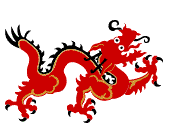Off Leash Attack Training Conducted with the decoy wearing a very heavy, thickly padded suit. The suit did not protect the feet or the head if the dog knocked the decoy over. The attack suit sometimes conditioned the dogs to attacking only someone wearing a thick and bulky suit. On several cases dogs that seemed to be aggressive failed to bite human intruders. The dogs then received training wearing a special attack muzzle. This muzzle was tighter and more secure than the normal basket muzzle used during transportation and vet exams. The dogs were released on a unprotected decoy to see if they would actually attempt to attack. It would be a heart stopper for the decoy when a dog stopped and attempted to remove the muzzle. Photo Below (Left): Handler scrambles to retrieve dog from off leash attack. Photo Below (Right): Line agitation conducted with the dogs receiving a on leash bite on a decoy. Handlers acted as decoy for each other.
Photo Below: The dog was not required to release his bite on command. Handlers usually had to choke the dog by closing the dog's windpipe to force the dog to open his mouth. The procedure required the handler to hold the dog collar with his left hand. The right hand was used to pinch the windpipe and force the dog to open his mouth. It was not uncommon for a dog to release, turn and bite the handler. This could occur so fast that it was difficult to prevent. As far as the dog was concerned, the handler was a unidentified human attempting to hurt him.
Photos Below: Japanese Handlers/Trainers Conducting Basic Obedience
Photo Below: The obstacle Course was physical exercise for the dog and a chance to develop trust and confidence in the handler
Previous information from PACAF MWDTC Course Material.
On 1 January 1970, the Center was officially renamed the PACAF Military Working Dog Training Center, necessitated due to the expanded use of dogs in the Air Force. On 28 December 1970, the Center moved into a newly constructed facility. The facilities had approximately 4,000 square feet of administrative and support floor space. It was the most modern dog training facility possessed by the military. In addition to a completely equipped and staffed Veterinary Clinic, it had 100 permanent (indoor) kennels that included eight hospital isolation kennels. The school was located in the cleared 2,000-ft. buffer zone surrounding a huge bomb dump located north of Kadena AB. This allowed larger training areas. Civilian handlers were again utilized to provide initial training to dogs. In the late 70s, the PACAF MWDTC conducted four formal resident courses of instruction : Patrol Dog Handler, Patrol Dog Handler Supervisor, Patrol /Drug Detector Dog and Patrol /Explosive Detector Dog course Drug Detector Dog classes used as training areas the numerous Army, Navy, and Marine installations, located on Okinawa. The Center also conducted mobile field training and staff assistance visits as approved by CINCPACAF/SP (for civilians that's military talk for the senior ranking Security Police Officer in the Pacific theater, or as I often referred to him, the Great Head Shepherd). The training center operated under one rule, provide as much support as possible to all field units. The Center procured dogs from the DOD Dog Center, Lackland Air Force Base, Texas, and occasionally accepted local donation dogs. Dogs procured from the DOD Dog Center were usually slow in arriving. The General in charge of PACAF, a pilot and dog lover, decided that small cockpits and the tight areas on aircraft called for small drug detector dogs. With his authorization , the Center started the Small Sniffer Dog (SSD) Program. Small dogs were procured from the pet shelters on Okinawa and trained as Narcotic Detector Dogs. The PACAF MWDTC however simply took the "a dog, is a dog, is a dog" approach. Small dogs found on Okinawa were trained as drug detector dogs using the same training methods as used on their German Shepherd cousins. These dogs were shipped throughout the Pacific area to search aircraft and other areas for illegal drugs. Less than 100 dogs were trained, with each base receiving several dog. The dogs were successfully used on the flight line to search arriving and departing aircraft. These dogs were trained using the exact same methods as their German Shepherd counterparts. Most were trained using a ball or a toy reward; very few, if any, were trained using food reward. The dogs were even given their own brand numbers, like their big cousins. Their serial number started out with the letters SSD (Small Sniffer Dog). The SSD's were the first military dogs that were allowed to retire. Several were returned to civilian life in the late 1970 |







